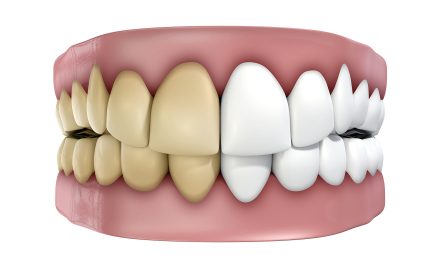Dental braces are an effective tool used to correct misaligned teeth and improve smiles. They work by applying gentle pressure to gradually shift teeth into the desired position.
This process can involve various types of braces, each designed to suit different dental needs.
Orthodontists play a crucial role in creating personalized treatment plans. They assess each patient’s mouth, ensuring that the braces chosen will lead to the best results.
Understanding how braces function can help individuals feel more comfortable and informed about their orthodontic journey.
Some may worry about the length of treatment or oral hygiene while wearing braces. Knowing what to expect can help alleviate concerns and make the experience smoother.
Key Takeaways
- Braces apply gentle pressure to align teeth.
- Orthodontists customize treatment plans for each individual.
- Maintaining oral hygiene is essential during treatment.
Understanding Dental Braces
Dental braces are tools used to straighten teeth and correct bite issues. They consist of several parts that work together to gradually move teeth into better positions.
Different types of braces can cater to individual needs and preferences.
Components of Braces
Braces have key components that play specific roles:
- Brackets: These are small squares attached to each tooth. They hold the archwire in place.
- Archwire: This wire connects all the brackets. It applies pressure to the teeth to move them.
- Ligatures: These are tiny rubber bands that hold the archwire to the brackets. They can come in various colors.
- Rubber Bands: These may be added to improve bite alignment. They connect both top and bottom braces.
Each part is essential for the treatment process, providing consistent pressure and helping to ensure effective tooth movement.
Types of Braces
There are several types of braces available:
- Metal Braces: These are the most common. Made from stainless steel, they are strong and effective.
- Ceramic Braces: These are similar to metal braces but less noticeable because they blend with the teeth.
- Lingual Braces: Placed on the back of teeth, they are hidden from view.
- Clear Aligners: Often referred to as invisible braces, these are removable and are made from clear plastic.
Each type has its benefits, allowing individuals to choose braces that fit their lifestyle and comfort.
How Braces Work
Braces apply gentle pressure to teeth over time. This pressure helps move teeth into better positions.
There are two main parts to understand: how braces correct bite issues and the different phases of treatment.
Correcting Malocclusion
Malocclusion refers to problems with the alignment of teeth. Common issues include crooked teeth, overbites, and underbites.
Braces help correct these problems by shifting the teeth gradually.
Braces consist of brackets, wires, and bands. The brackets are glued to each tooth and connected by a wire. As gentle pressure is applied, the teeth move into their desired position. This may take months or years, depending on the severity of the malocclusion.
Sometimes, additional devices like expanders or retainers are used. These can help create space or maintain the new tooth positions after the braces are removed.
Regular adjustments are made during visits to the orthodontist to ensure progress.
Phases of Orthodontic Treatment
Orthodontic treatment with braces typically has several phases. The first phase involves the initial examination and planning.
During this time, the orthodontist takes X-rays and molds of the teeth. This helps in creating a personalized treatment plan.
The second phase includes the actual placement of braces. Brackets are attached, and wires are threaded through. The orthodontist tightens the wires at regular intervals. This ensures continued movement of the teeth.
Lastly, after the desired position is achieved, braces are removed. A retainer is often given to maintain the new alignment.
Retainers are crucial because teeth can shift back to their original positions without them.
Each phase plays a key role in achieving a healthy and straight smile.
The Role of Orthodontists
Orthodontists are specialists who focus on correcting teeth and jaw alignment. They play a key role in diagnosing orthodontic issues and creating effective treatment plans.
Consultation and Diagnosis
During the first appointment, the orthodontist conducts a thorough consultation. This includes examining the patient’s mouth, teeth, and facial structure.
To get a clear picture of the patient’s needs, the orthodontist may take X-rays. These images help identify any malocclusion or misalignment.
After the examination, the orthodontist discusses findings and explains any orthodontic issues. This step is crucial for ensuring the patient understands their condition and what to expect.
Creating a Treatment Plan
Once the diagnosis is complete, the orthodontist designs a personalized treatment plan. This plan takes into account the specific needs of the patient.
The treatment plan may involve different options, such as traditional braces, clear aligners, or retainers. Each method has its benefits, depending on the severity of the malocclusion.
The orthodontist explains the timeline and goals of the treatment. Regular follow-ups are scheduled to monitor progress and make necessary adjustments to the braces or aligners.
Clear communication helps the patient stay informed throughout the journey.
Types and Selection of Braces
Choosing the right type of braces is important for both treatment effectiveness and personal comfort. Different types of braces cater to specific needs, preferences, and lifestyles.
Traditional Metal Braces
Traditional metal braces are the most common type used by orthodontists. They consist of metal brackets bonded to the teeth and connected by wires.
These braces actively work by applying consistent pressure to gradually shift teeth into the desired position. They are typically made from stainless steel and are durable, making them a reliable choice.
The treatment with metal braces usually lasts from 1 to 3 years. Patients may have options to add colorful elastic bands, making them a fun choice for younger users.
Ceramic and Clear Braces
Ceramic braces use clear or tooth-colored materials, making them less visible than metal braces. They are similar in function to traditional metal braces but offer a more discreet option.
Patients who prefer a less noticeable look often select ceramic braces. The brackets blend in with the natural color of teeth, making them popular among adults and teens.
However, ceramic braces can be more fragile and may stain over time if proper care is not followed. The treatment length is similar, lasting from 1 to 3 years.
Lingual and Invisible Braces
Lingual braces are placed on the back of the teeth, making them virtually invisible from the front. They work the same way as traditional braces but are less visible, which is appealing for many adults.
Invisible braces, also known as Invisalign, use clear plastic aligners to gradually shift teeth without wires or brackets. They are removable, making them convenient for eating and cleaning.
Both lingual and invisible options require discipline since aligners must be worn for 20-22 hours a day to be effective. Treatment times can vary, often ranging from several months to over two years.
Duration and Stages of Treatment
The treatment with dental braces involves several key stages and can vary in duration. Each stage plays an important role in achieving the desired teeth alignment.
Initial Placement to Adjustments
When braces are first placed, the process takes about 1 to 2 hours. The orthodontist attaches brackets to each tooth and connects them with a wire. This initial setup begins to move teeth into better positions.
After placement, regular adjustments occur about every 4 to 6 weeks. During these visits, the orthodontist tightens the wires and may change the rubber bands or brackets. This helps guide the teeth as they shift.
Each adjustment visit lasts around 20 to 30 minutes. The total length of treatment usually ranges from 1 to 3 years, depending on the complexity of the case.
Monitoring and Retention
After braces are removed, monitoring continues. This phase ensures teeth remain in their new positions.
Patients often receive retainers, which are custom-made devices. They may be fixed or removable.
Retainers are important for maintaining the new tooth alignment. They need to be worn as instructed, typically full-time for a few months and then part-time for several years.
Regular follow-up appointments help keep track of the results. These visits occur every few months for the first year after treatment and less frequently after. This careful monitoring helps ensure a lasting, effective outcome.
Oral Hygiene with Braces
Maintaining oral hygiene while wearing braces is crucial for preventing dental issues. Proper care includes daily cleaning routines and regular professional dental visits.
Daily Cleaning and Maintenance
Brushing teeth with braces requires extra attention. It’s best to use a soft-bristled toothbrush and fluoride toothpaste.
Brushing should happen at least twice a day, focusing on all areas of the teeth, gums, and braces.
Flossing is just as important. Special orthodontic flossers or a Waterpik can make this easier. Flossing removes food particles and plaque that a toothbrush might miss.
A good tip is to avoid sticky and hard foods, which can damage braces and complicate cleaning.
Rinsing with an antimicrobial mouthwash can further help maintain oral health and reduce bacteria buildup.
Professional Dental Care
Regular visits to the dentist are essential for anyone with braces. These check-ups allow dentists to monitor oral health and ensure the braces are working correctly.
Cleaning appointments may involve professional cleaning to remove plaque and tartar. Dentists might also check the condition of the gums and surrounding areas.
Patients should inform their dentist about any discomfort or concerns regarding their braces. Early detection of issues can prevent bigger problems later on.
Taking care of oral hygiene aids in achieving the best results from orthodontic treatment.
Life with Braces
Living with braces brings some changes to everyday routines and habits. It’s important to be aware of new eating habits, ways to manage discomfort, and how daily activities may be impacted.
Eating Habits
When someone has braces, certain foods can cause problems. It’s best to avoid hard, sticky, or crunchy foods.
Foods like popcorn, gum, and hard candies can damage the braces or get stuck in them.
Instead, softer options like yogurt, mashed potatoes, and smoothies are good choices. Eating smaller bites can also help.
Always remember to rinse the mouth after meals to remove any leftover food.
Many people find dental wax helpful. It can be applied to brackets to reduce irritation in the mouth.
Managing Discomfort
Discomfort is common when getting braces. The wires and brackets can cause pain, especially after adjustments.
Over-the-counter pain relievers can help address this discomfort.
Using dental wax can reduce irritation from brackets rubbing against the gums and cheeks. Ice packs on cheeks can also soothe swelling.
Keeping a soft toothbrush for gentle cleaning helps avoid more discomfort.
Following up with orthodontist appointments is crucial for maintaining comfort and addressing any issues quickly.
Impact on Daily Activities
Braces can also affect daily activities. Playing certain sports may require additional protection, like a mouthguard, to prevent injury.
Brushing and flossing take a bit longer. Special tools like floss threaders can make cleaning between the brackets easier.
Social interactions might feel different initially. Some may feel self-conscious about their braces, but over time this usually fades.
Embracing the smile transformation can help. Adjusting to braces is a gradual process, but with time, it becomes part of the daily routine.
Cost and Insurance Coverage
The cost of dental braces can vary widely based on several factors, such as type, treatment length, and the patient’s location. Understanding insurance coverage and payment options can help manage these costs efficiently.
Determining the Cost of Treatment
Braces can range in price from $3,000 to $10,000. The final cost depends on the type of braces chosen, like traditional metal, ceramic, or clear aligners. Each type has a different price point.
Additional factors include:
- Treatment Length: Longer treatments typically cost more.
- Severity of Case: Complex cases may require more adjustments.
- Orthodontist Fees: Different orthodontists may charge differently.
Patients should get a detailed estimate from their orthodontist. This estimate often includes consultation, monthly adjustments, and retainers.
Navigating Insurance and Payment Options
Dental insurance may cover a portion of the braces cost. Many plans consider braces an essential treatment and may cover 50% to 80% of the total expenses.
Key Points:
- Medicaid: Some states offer Medicaid coverage for braces, especially for kids in need.
- Health Savings Accounts: These accounts can help manage costs with pre-tax dollars.
Patients should check their insurance policy details to see what is covered. Payment plans are often available for those without insurance. It’s beneficial to discuss all available options with the orthodontist’s office.
Addressing Common Orthodontic Problems
Braces help fix several common issues with teeth and bites. These problems include overcrowding, spacing issues, and specific bite corrections. Understanding these issues can guide patients through their orthodontic journey.
Overcrowding and Spacing Issues
Overcrowding occurs when there isn’t enough space for all teeth to fit properly in the mouth. This can lead to crooked teeth and problems with cleaning. Orthodontists may recommend spacers to create room.
Spacers are small devices placed between teeth to help widen the arch.
In contrast, spacing issues happen when there are gaps between teeth. This can be caused by missing teeth or smaller-than-normal teeth. Braces can close these gaps by shifting teeth into correct positions.
To treat overcrowding, the orthodontist may also extract teeth if needed. Proper treatment ensures teeth are aligned, making them easier to clean and improving overall dental health.
Bite Corrections
Bite problems include conditions such as overjet, open bite, and crossbite. An overjet occurs when the upper front teeth extend too far over the lower teeth. This can cause difficulty when chewing or biting.
Open bite is when the upper and lower teeth do not touch when the mouth is closed. This can affect speech and chewing. Crossbite happens when upper teeth are placed inside lower teeth, leading to uneven wear and potential jaw pain.
Braces help to realign teeth, correcting these bite problems. In some cases, additional treatment like headgear may be necessary. Each of these corrections plays a significant role in improving bite and oral function.
Risks and Complications
Braces can improve dental alignment but also come with risks. It is important to know the potential complications that can arise during treatment.
Tooth Decay and Gum Disease
Braces can make oral hygiene more challenging. Food particles can get trapped in brackets and wires, leading to plaque buildup. If not cleaned properly, this plaque can cause tooth decay and gum disease.
Daily brushing and flossing are crucial for patients with braces. A dentist may recommend special tools like interdental brushes or floss threaders to help maintain clean teeth.
Regular dental check-ups are also important, as they allow for professional cleanings and early detection of any problems.
Root Resorption and TMJ Issues
Root resorption is a risk linked to orthodontic treatment. This condition occurs when the body absorbs the root structure of teeth. It may lead to tooth mobility and even loss of teeth in severe cases.
Additionally, some patients may experience TMJ (temporomandibular joint) issues during or after wearing braces. Signs include jaw pain, clicking sounds, or difficulty in opening and closing the mouth.
Regular monitoring by an orthodontist can help reduce the risks associated with these complications.
Frequently Asked Questions
This section addresses some common queries about dental braces. It covers side effects, costs, types, and more.
What are the common side effects of wearing dental braces?
Some common side effects include mouth sores, discomfort, and difficulty eating at first. Patients may also experience tooth sensitivity after adjustments. Braces can cause changes in speech temporarily.
How do braces correct crowded teeth?
Braces use brackets and wires to apply gentle pressure on teeth. This pressure helps shift crowded teeth into proper alignment. The process gradually creates more space in the mouth.
What is the typical price range for fitting dental braces?
The cost for dental braces typically ranges from $3,000 to $8,000. Factors like location and treatment type can affect pricing. Insurance may cover part of these expenses.
What are the different types of braces available and their respective costs?
Different types of braces include metal, ceramic, and lingual braces. Metal braces usually cost between $3,000 and $7,000. Ceramic braces range from $4,000 to $8,000, while lingual braces can be more expensive, generally costing $8,000 or more.
What are the expected results of dental braces before and after treatment?
Before treatment, teeth may be misaligned or crowded. After braces, teeth are straighter and more evenly spaced. Most patients achieve a noticeable improvement in their smile and bite.
Is there an age limit for getting teeth braces?
There is no strict age limit for braces. While most patients are children or teens, adults can also benefit from braces.
Orthodontists evaluate cases individually, regardless of age.
















